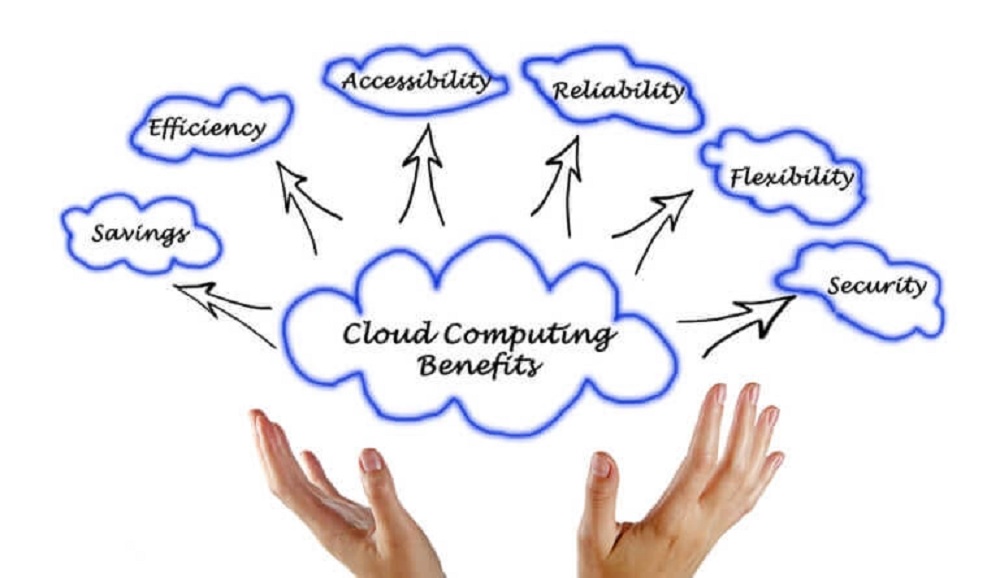Cloud computing refers to the delivery of computing services over the Internet. It allows users to access and use a pool of shared computing resources, such as virtual machines, storage, databases, and applications, without the need for local infrastructure or physical hardware.
In other words, cloud computing enables users to leverage remote servers and resources to store, process, and manage data and applications.
How does Cloud Computing work?
Cloud computing operates through a network of servers, often located in data centers, that are connected to the internet. Users access cloud resources and services through the internet, typically using a web browser or a specialized application interface.
The cloud service provider manages and maintains the underlying infrastructure, including hardware, networking, and software, while users can focus on utilizing the resources without worrying about the technical details.
What are the Benefits of Cloud Computing?
Cloud computing has transformed the way businesses and individuals use technology. It provides seamless access to storage, computing power, and applications over the internet—eliminating the need for physical infrastructure or large upfront costs. If you’re looking for a secure and efficient way to store your media files, explore the Best Cloud Storage for Photos and Pictures for reliable storage solutions.
Cloud computing offers several advantages, including:
Scalability:
Cloud services can easily scale up or down based on the user’s needs, allowing for efficient resource allocation.
Cost savings:
Cloud computing eliminates the need for upfront investments in hardware and infrastructure, as well as the costs of maintenance and upgrades.
Flexibility and accessibility:
Users can access cloud resources and applications from anywhere with an internet connection, using various devices.
Reliability and availability:
Cloud service providers typically offer robust infrastructure with redundancy and failover mechanisms, ensuring high availability and minimal downtime.
Collaboration and sharing:
Cloud platforms facilitate easy collaboration and file sharing among users, improving productivity and teamwork.
Data backup and disaster recovery:
Cloud providers often have built-in data backup and disaster recovery mechanisms to safeguard data and ensure business continuity.
Read Also: Optimize Server Performance with Real-Time Monitoring
What are the Different Types of Cloud Computing Models?
Cloud computing offers various models to meet different needs and requirements. These different models provide varying levels of control and abstraction, catering to different user needs and preferences in the cloud computing ecosystem.
There are primarily three types of cloud computing models:
Public cloud:
In a public cloud, computing resources are owned and operated by a third-party cloud service provider. These resources are shared among multiple users and are accessible over the internet. Public clouds offer cost-effectiveness, scalability, and ease of use, making them suitable for a wide range of applications.
Private cloud:
A private cloud is dedicated to a single organization and is either managed internally or by a third-party provider. Private clouds provide more control and customization options, which make them suitable for organizations with specific security, compliance, or performance requirements.
Hybrid cloud:
A hybrid cloud combines elements of both public and private clouds. It allows organizations to leverage the benefits of both environments, enabling them to keep sensitive data and critical applications on a private cloud while using public cloud resources for scalability, cost-efficiency, or less sensitive workloads.
What are the Key Characteristics of Cloud Computing?
Cloud computing operates on a pay-per-use or metered basis, where users are charged based on their actual resource consumption, providing cost-effectiveness and flexibility.
These characteristics collectively contribute to the flexibility, scalability, accessibility, and cost efficiency that make cloud computing a powerful and transformative technology paradigm.
Cloud computing is characterized by several key features:
On-demand self-service:
Users can provision computing resources, such as virtual machines or storage, on demand without requiring human intervention from the cloud service provider.
Broad network access:
Cloud services are accessible over the network through standard protocols and can be used by various devices, including laptops, smartphones, and tablets.
Resource pooling:
Cloud providers pool and share resources (e.g., processing power, storage, bandwidth) to serve multiple users concurrently, achieving efficiency and economies of scale.
Rapid elasticity:
Cloud resources can be rapidly scaled up or down to meet changing demands. This scalability ensures that users can quickly access additional resources during peak usage and release them when no longer needed.
Measured service:
Cloud usage is often monitored, and users are billed based on their actual consumption. This pay-per-use model allows for cost optimization and resource allocation.
What are Some Popular Cloud Computing Service Providers?
Cloud computing service providers play a pivotal role in enabling organizations to leverage the benefits of cloud computing. These providers offer a range of services and resources that can be accessed and utilized over the Internet.
These providers offer diverse services such as infrastructure provisioning, storage, computing power, database management, artificial intelligence, and analytics tools.
Each provider has its own unique set of offerings, pricing models, and features, allowing businesses to select the provider that best aligns with their specific needs and requirements.
Cloud computing service providers empower organizations with the scalability, flexibility, and cost-effectiveness required to drive innovation, accelerate digital transformation, and meet the ever-evolving demands of the modern business landscape.
There are several popular cloud service providers including:
Amazon Web Services (AWS):
Amazon Web Services is one of the largest cloud providers, offering a wide range of services, including computing power, storage, databases, analytics, and machine learning.
Microsoft Azure:
A comprehensive cloud platform by Microsoft that provides services for computing, storage, networking, analytics, AI, and more. It also integrates well with Microsoft software and tools.
Google Cloud Platform (GCP):
Google’s cloud services platform offers a diverse set of services, including computing, storage, databases, machine learning, and data analytics, with strong capabilities in AI and big data.
IBM Cloud:
IBM’s cloud computing platform, provides infrastructure services, AI and machine learning tools, blockchain, data storage, and various industry-specific solutions.
Oracle Cloud:
Oracle’s cloud offering includes infrastructure services, databases, enterprise applications, and development tools, with a focus on supporting hybrid cloud deployments.
Alibaba Cloud:
A leading cloud provider in China, offering a wide range of services similar to other providers, with a strong focus on serving the Asian market.
Salesforce:
Known for its customer relationship management (CRM) software, Salesforce also provides a cloud platform (Salesforce Platform) for building and deploying business applications.
VMware Cloud:
VMware offers cloud services that enable organizations to seamlessly extend their on-premises infrastructure to the cloud, providing a unified environment for managing applications and resources.
What is the difference between Infrastructure as a Service (IaaS), Platform as a Service (PaaS), and Software as a Service (SaaS)?
Each model offers varying levels of control, management responsibility, and abstraction, catering to different user needs and preferences.
These cloud computing models provide organizations with the flexibility to choose the level of involvement they desire, whether it’s managing the infrastructure, building custom applications, or simply using ready-made software solutions, ultimately enabling businesses to optimize their IT resources and focus on their core objectives.
Infrastructure as a Service (IaaS):
IaaS provides virtualized computing resources over the internet, such as virtual machines, storage, and networks. Users have more control over the infrastructure, as they are responsible for managing the operating systems, applications, and data hosted on the provided infrastructure.
Platform as a Service (PaaS):
PaaS offers a development platform and environment to build, deploy, and manage applications. It includes the underlying infrastructure, runtime environment, and development tools, allowing users to focus on application development while leaving the management of the infrastructure to the PaaS provider.
Software as a Service (SaaS):
SaaS delivers fully functional applications over the internet, accessible through a web browser or API. Users can use the software without worrying about installation, maintenance, or underlying infrastructure. Examples of SaaS include email services, customer management systems, and collaboration tools.
How does cloud storage work?
Cloud storage is a service that allows users to store and retrieve data over the internet. Here’s how it generally works:
- Data is stored on remote servers maintained by the cloud storage provider.
- Users can upload or transfer data to the cloud storage service via the Internet using various protocols or APIs.
- The data is typically replicated and distributed across multiple servers and data centers for redundancy and fault tolerance.
- Users can access their stored data anytime and from anywhere with an internet connection.
- Cloud storage services often provide data encryption, access controls, and other security measures to protect data.
- Users can manage their stored data, perform backups, and organize files through user-friendly interfaces or programmatically via APIs.
What is Virtualization, and how is it related to Cloud Computing?
Virtualization is the process of creating virtual instances or representations of physical resources, such as servers, storage devices, or networks. It allows multiple virtual machines (VMs) or virtualized environments to run on a single physical server, effectively utilizing the available hardware resources.
Virtualization is closely related to cloud computing, as it forms the foundation of many cloud services. Cloud providers use virtualization to partition physical resources into virtualized instances that can be allocated to users as needed. Virtualization enables the efficient sharing and utilization of resources among multiple users, leading to improved scalability, flexibility, and cost-effectiveness.
What are the Security Considerations in Cloud Computing?
Security is a critical aspect of cloud computing. Some important security considerations include:
Data protection:
Ensure data confidentiality, integrity, and availability through encryption, access controls, backup strategies, and secure data transmission.
Identity and access management:
Implement robust authentication and authorization mechanisms to control access to cloud resources and data.
Compliance and legal requirements:
Understand and comply with relevant industry regulations and data protection laws.
Secure APIs:
Securely manage and control access to cloud services and resources through well-defined and properly authenticated APIs.
Vulnerability management:
Regularly patch and update software, monitor for vulnerabilities, and apply security best practices to mitigate risks.
Incident response and recovery:
Have plans and processes in place to respond to security incidents and recover data in case of breaches or disasters.
Shared responsibility:
Understand the division of security responsibilities between the cloud provider and the cloud user and ensure both parties fulfill their respective roles.
What are the Potential Challenges or Risks Associated with Cloud Computing?
While cloud computing offers numerous benefits, there are also challenges and risks to consider:
Data security and privacy:
Storing data in the cloud may raise concerns about unauthorized access, data breaches, or compliance with privacy regulations.
Dependence on service providers:
Organizations rely on cloud providers for their critical services, and any disruptions or service outages can impact operations.
Vendor lock-in:
Transferring data or applications from one cloud provider to another can be complex, leading to potential vendor lock-in and limited flexibility.
Data transfer and latency:
Moving large amounts of data to and from the cloud can be time-consuming, especially for organizations with limited internet bandwidth.
Cost management:
Cloud costs can escalate if not properly managed, as users pay for resource usage and may need to monitor and optimize their consumption.
Limited control and visibility:
Organizations may have less control and visibility over the underlying infrastructure, making it crucial to choose reliable providers and establish strong service-level agreements (SLAs).
These are just some of the considerations and challenges associated with cloud computing. Organizations must assess their specific requirements, conduct thorough risk assessments, and implement appropriate mitigation strategies when adopting cloud services.
What is the difference between Cloud Computing and Edge Computing?
Cloud computing and edge computing are complementary approaches in the realm of distributed computing:
Cloud computing:
In cloud computing, data processing and storage occur in centralized data centers located at a distance from the end-user. The cloud infrastructure offers massive scalability, vast storage capacity, and powerful computing resources. It is suitable for applications that require extensive data analysis, heavy computational tasks, or centralized management.
Edge computing:
Edge computing, on the other hand, involves processing data at or near the edge of the network, closer to the data source or end-user device.
By bringing computing resources closer to the point of data generation, edge computing reduces latency, improves real-time processing, and enhances user experience. It is particularly useful for applications that demand low latency, high bandwidth, or offline capabilities.
Both cloud computing and edge computing have their unique advantages, and they can be combined to form a hybrid architecture that leverages the benefits of both centralized cloud resources and decentralized edge resources, depending on specific application requirements.
How does Cloud Computing Impact Businesses and Industries?
Cloud computing has significantly impacted businesses and industries, revolutionizing the way organizations operate and deliver services. Cloud computing has had a transformative impact on businesses and industries in several ways:
Scalability and agility:
Cloud computing enables businesses to scale their resources up or down quickly based on demand. This agility allows for cost optimization, faster time to market, and the ability to respond rapidly to changing business needs.
Cost savings:
Cloud computing eliminates the need for upfront investments in hardware and infrastructure, reducing capital expenditure. It also reduces ongoing operational costs associated with maintenance, upgrades, and energy consumption.
Enhanced collaboration:
Cloud platforms provide collaborative tools and file-sharing capabilities that foster teamwork and enable employees to work together more effectively, regardless of their physical locations.
Global reach:
Cloud services can be accessed from anywhere with an internet connection, enabling businesses to expand their operations globally and serve customers in different regions without setting up local infrastructure.
Innovation and experimentation:
Cloud computing provides a flexible and cost-effective environment for innovation, experimentation, and the development of new applications and services.
Data analytics and insights:
Cloud-based data analytics tools and services enable businesses to harness the power of big data, perform advanced analytics, gain actionable insights, and make data-driven decisions.
Business continuity and disaster recovery:
Cloud providers typically have robust backup and disaster recovery mechanisms, ensuring that businesses can recover data and maintain operations even in the event of unforeseen disruptions.
These are just a few examples of how cloud computing has transformed businesses across various industries, driving efficiency, competitiveness, and innovation.
What are some common use cases or applications of cloud computing?
Cloud computing finds application in various domains and use cases, including:
Infrastructure hosting:
Organizations can migrate their IT infrastructure to the cloud, hosting servers, storage, and networking components in the cloud environment.
Software development and testing:
Cloud platforms offer development and testing environments, allowing teams to collaborate, build, and deploy applications more efficiently.
Big data processing and analytics:
Cloud computing provides the resources and tools for processing and analyzing large volumes of data, enabling businesses to gain insights and make informed decisions.
Web and mobile applications:
Cloud platforms offer scalable and reliable infrastructure for hosting web and mobile applications, ensuring high availability and seamless user experiences.
Disaster recovery and backup:
Cloud-based backup services provide secure and scalable solutions for data backup, ensuring business continuity and quick recovery in case of disasters.
Internet of Things (IoT):
Cloud computing is instrumental in managing and analyzing data generated by IoT devices, facilitating real-time processing, storage, and integration with other systems.
Artificial Intelligence and Machine Learning:
Cloud platforms offer scalable computational resources and pre-built AI/ML tools for training and deploying machine learning models.
Collaboration and productivity:
Cloud-based productivity suites and collaboration tools enable teams to work together, share documents, and communicate effectively, irrespective of location.
These are just a few examples, and the applications of cloud computing continue to expand as technology advances and businesses discover new possibilities.
How can I migrate my existing applications or infrastructure to the cloud?
Migrating existing applications or infrastructure to the cloud involves careful planning and execution. Here are some general steps to consider:
Assessment:
Evaluate your existing applications and infrastructure to determine their suitability for Cloud migration. Consider factors like dependencies, resource requirements, data sensitivity, and compliance requirements.
Cloud provider selection:
Choose a cloud provider that aligns with your requirements, considering factors such as service offerings, pricing models, security, compliance, and support.
Migration strategy:
Define a migration strategy based on your needs and priorities. Options include the lift-and-shift approach (rehosting), rearchitecting applications for cloud-native deployment, or a hybrid approach.
Data migration:
Plan and execute the migration of your data to the cloud. This may involve transferring data over the network or using physical media, depending on data volume and network bandwidth.
Application migration:
Migrate your applications to the cloud using the chosen approach. This may involve reconfiguring infrastructure components, modifying application code, or leveraging cloud-specific services.
Testing and validation:
Conduct thorough testing to ensure that migrated applications and infrastructure function correctly in the cloud environment. Test performance, scalability, security, and compatibility with other systems.
Post-migration optimization:
Optimize your cloud resources, configurations, and costs. Fine-tune performance, security settings, and auto-scaling rules as necessary.
Monitoring and maintenance:
Implement monitoring and management tools to monitor the performance, availability, and security of your cloud resources. Regularly update and patch software components.
It is crucial to have a well-defined migration plan, involve key stakeholders, and consider engaging cloud migration experts or consulting services if needed. Each migration is unique, so adapt the process to your specific requirements and circumstances.
Conclusion
Cloud computing is a transformative technology that has revolutionized the way businesses and individuals access and utilize computing resources. It provides on-demand access to a wide range of services, including storage, computing power, and applications, over the Internet.
The key characteristics of cloud computing, such as on-demand self-service, broad network access, resource pooling, rapid scalability, and pay-per-use pricing, offer unprecedented flexibility, scalability, accessibility, and cost-efficiency.
Cloud computing enables organizations to streamline their IT operations, improve agility, drive innovation, and reduce costs. With the support of cloud computing service providers and the availability of different models such as IaaS, PaaS, and SaaS, businesses can harness the power of the cloud to transform their operations, enhance collaboration, and adapt to the ever-changing demands of the digital era.
Overall, cloud computing has emerged as a game-changer, empowering organizations to leverage advanced technologies, optimize resource utilization, and focus on their core competencies to achieve their business goals.









